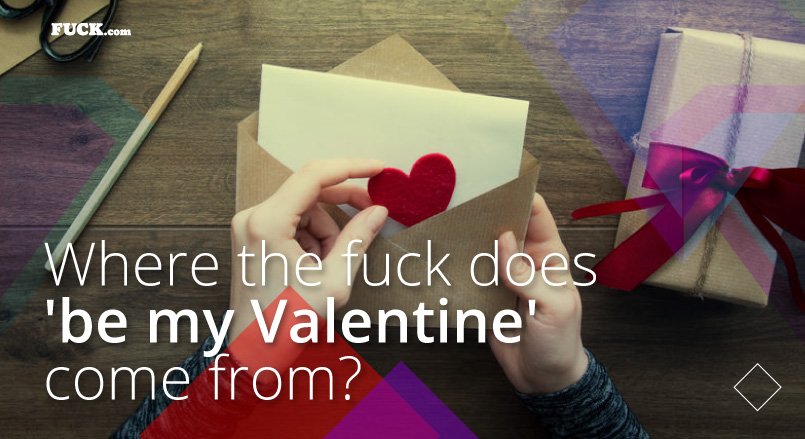Need a conversation starter for your next romantic outing? The history of Valentine's Day will be a hot topic this week as the infamous lover's holiday approaches. Quiz yourself and your date on what you know about this heart-shaped day.
Valentine’s Day is the most romantic time of year, a time when even the most reserved of us express our love in the most poetic of terms.
Like a lot of holidays, it has traditions that go back for centuries, but not as back as far as we tend to think. Over the centuries, people have celebrated Valentine’s Day in all kinds of different ways.

In search of the historical Saint Valentine
There's a lot of talk about 'Saint Valentine'. You’ve probably heard, that he was a priest or bishop who conducted marriages for Roman soldiers who'd been forbidden by the emperor to marry. It’s a good story, but there are four big problems:
F. There’s no record of soldiers being forbidden to marry
U. There’s no record of Saint Valentine conducting marriages
C. The early church didn’t really conduct marriages for ordinary members
K. There’s not really any record of Saint Valentine doing anything... WTF?! 0.o
There are actually several Saints Valentine - Valentinus was a pretty common Roman name - but we know very little about them. All the stories about the romantic deeds of this early saint are much later.
Some people claim that Valentine’s Day was created as a replacement for the Roman holiday of Lupercalia. A day in which priests ran through the streets mostly naked, whipping people with thongs, believed by the Romans to enhance fertility.
However, it’s hard to find a connection between this holiday and Valentine’s Day. Especially when nearly a thousand years passed between these wild pagan rites and the medieval celebration of love.
Love at first sight
The first reference to love on Saint Valentine’s day comes from Geoffrey Chaucer. He wrote in The Parliament of Fowls that birds choose their mates on February 14.
Love spread from the birds to humans by the 15th century. In the early 1400s, there are references to Valentine’s Day in French courtly love poetry. The tradition had spread to Britain by the late 15th century, although the written references to it suggest that the custom was already well-known.
In the 17th century, there seems to have been a tradition that the first person of the opposite sex you saw on Valentine’s Day morning was to be your Valentine for the day. He or she would become a sort of temporary sweetheart, for whom you’d buy small gifts, recite poems, and so on.
In order to avoid running into someone undesirable, people would try to arrange to see a particular person first that morning. Shakespeare's Hamlet includes a reference to this custom, with a story about a young woman waiting at a man’s window early in the morning in hopes of being his Valentine.
.jpg.a1f269188353c10a1c76fedc1155d1ee.jpg)
Married men would arrange to act as Valentine to a friend’s wife or daughter, possibly as a means of keeping away inappropriate suitors.
The 17th-century diarist and naval official Samuel Pepys records records expecting to spend £4 or £5 on a ring as a gift for his cousin Roger’s wife, who was to be his Valentine. That doesn’t seem like much, but £4 or £5 in 1668 would be the equivalent of hundreds or even thousands of pounds in modern money.
Pepys also details lots of Valentine’s Day hijinks, including trying to trick a young man who had been chosen to be Mrs Pepys’ Valentine to see him first instead, “thinking to have made him kiss me.” The “notable, stout, witty boy” saw through the ruse, however.
Roses are red, violets are blue....
The first mention of a romantic Valentine’s Day comes from a poem, so it’s only fitting that poetry should continue to play a big part in the holiday.
Probably the most notorious Valentine’s Day verse is the old “roses are red, violets are blue.” A poem that hasn’t been spoken without irony since … well … probably since 1784, when it first saw print in a collection of nursery rhymes called Gammer Gurton’s Garland.
The history of holiday customs in Britain takes a huge turn during the industrial revolution. There are various reasons, but the one we’re concerned with right now has to do with cheap printing, cheap(ish) postage, and relatively widespread literacy.
The first known British Valentine’s Day card dates from 1797. This makes Valentine’s Day cards among the earliest holiday cards, nearly 50 years older than Christmas cards.
Today Valentine’s Day is both a day for couples to celebrate their love and a day for single people to make impulsive, ill-advised (or maybe inspired!) decisions in search of romantic happiness. If you’ve ever been single at a nightclub on Valentine’s Day, you might start to think that maybe pulling a name out of a hat or just kissing the first person you see wouldn’t be so bad after all.
Share your Valentine's Day stories. Good or bad, we want to hear about them! Leave a comment below or start a thread in the forum.
This article was contributed by one of our talented guest writers. Fancy yourself a writer? Let us know! [email protected]





Join the conversation
You are posting as a guest. If you have an account, sign in now to post with your account.
Note: Your post will require moderator approval before it will be visible.
There are no comments to display.